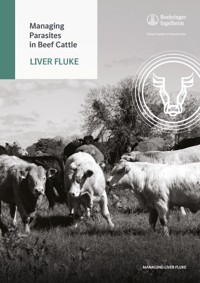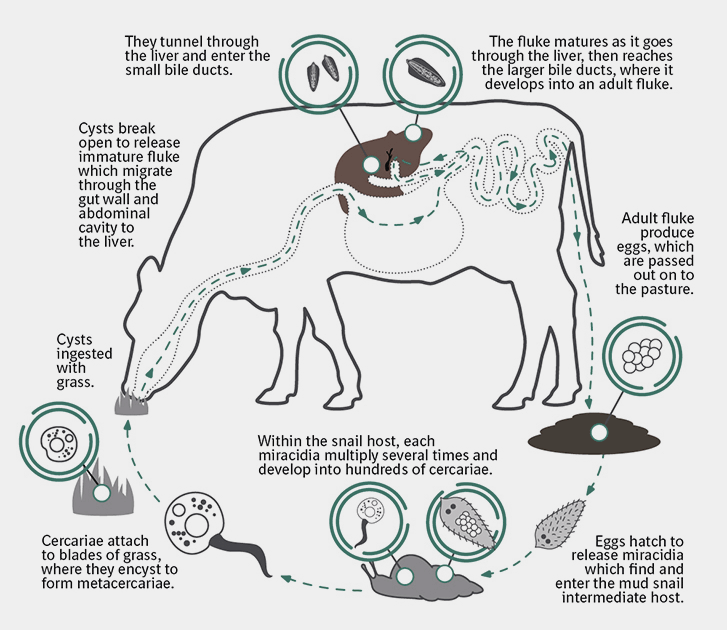
WHAT IS IT?
The liver fluke parasite, Fasciola hepatica, is responsible for causing the disease fasciolosis. The parasite is not species specific and can infect cattle, sheep and other grazing animals. Animals do not develop an effective immunity to liver fluke, such that both adult and young animals are at risk of infection.
WHAT IMPACT DOES IT HAVE?
Fasciolosis in beef cattle is often a sub-clinical chronic disease, with many farmers unaware that it is affecting their animals unless they receive feedback from the abattoir that livers are being condemned due to the presence of fluke or fluke damage.
Clinical signs of live fluke are often vague; animals infected with the parasite experience depressed appetite and impaired feed conversion. Indeed, even mild liver fluke infestation in growing cattle has been shown to depress feed intake by up to 11% and result in a 9% reduction in weight gain in growing cattle.1 Heavy fluke burdens can result in severe emaciation, anemia and low blood protein levels, resulting in sub-mandibular oedema, or bottle-jaw.
The effects of liver fluke are estimated to cost the British cattle industry approximately £23million.2
Liver fluke can affect body condition and fertility, and can result in a drop in milk yield in dairy cows. In addition to affecting productivity, fluke infection can increase the susceptibility of animals to other infections, such as clostridial disease. Like beef cattle, dairy animals typically suffer from the chronic form of fluke infection.
Liver Fluke Fact Sheet

For more Liver Fluke Resources

LIFE CYCLE
Adult fluke live in the bile ducts of the host animal's liver and produce eggs (see Fig.11), which are passed out with the faeces onto the pasture. Each adult fluke is capable of laying up to 25,000 eggs per day.
- Eggs hatch to release miracidia, which must find and enter the mud snail intermediate host (Galba truncatula) within three hours of hatching.
- Within the snail host, miracidia multiply several times, ultimately developing into cercariae. Each individual miracidium entering a snail can result in 600 cercariae leaving it.
- Cercariae attach themselves to blades of grass, where they encyst to form metacercariae. These cysts are the infective form of the parasite, picked up by grazing animals.
- Once they've been eaten, the cysts break open to release the immature stage fluke, which migrate towards the liver. They tunnel through liver tissue, enter the small bile ducts where they mature further, then ultimately move into the large bile ducts and gall bladder, to complete their development to egg-laying adult fluke.
- The time taken from picking up fluke infection to the adult egg-laying stage being reached is approximately 10 - 12 weeks in cattle.
- Similarly, the time taken from fluke eggs being deposited on the pasture to the infective cysts being formed is about 12 weeks.
DIAGNOSTICS
It is possible to detect liver fluke infection using several different approaches; each has advantages and limitations.
Commonly used tests include:
- Faecal Egg Counts (FECs) can be used to determine whether an animal has an adult fluke infection. This test will not identify immature fluke burdens or give a quantitative assessment of burden. False negatives can occur as eggs are shed sporadically and animals may also test positive in the weeks following treatment due to residual eggs being shed from the gall bladder.
- Coproantigen ELISA, which identify the presence of protein shed by the fluke in the faeces. This can identify the presence of late immature and adult fluke. It is most useful to test the fluke status of individual animals, and can be used to assess treatment efficacy.
- Serology can be performed on milk and blood and assesses antibody levels as an indicator of exposure to the parasite. The test can provide a useful screening tool, but it's important to remember that antibody will persist for several months following treatment. One of the best forms of feedback on liver fluke infection within the grazing herd comes from abattoir returns.
TREATMENT AND MANAGEMENT
Beef Cattle
One way to break the fluke life cycle is to reduce numbers of, or exposure to, the mud snail, which is the intermediate host for liver fluke. To do this, muddy areas of fields should be drained, so the snails can no longer survive there, or fenced off to prevent access to the snails. However, this is not always practical.
For beef cattle, it may be appropriate to give a treatment whilst stock is out at grass and at housing. On farms with a high risk of fluke infection early in the grazing season, due to infection by metacercariae that are released onto the pasture after overwintering in the snail host, a summer treatment in June or July may be warranted.
TRODAX® (nitroxynil) kills adult and late immature fluke (more than 8 weeks after infection), and can be used as part of a strategic control programme to reduce pasture re-contamination and ensure animals maximise the production benefit from grass. If infected cattle are left untreated, eggs produced by adult fluke will be passed out onto the pasture to continue their lifecycle.
Animals bought in, especially from known fluke endemic areas, should be checked for the presence of fluke infection. Quarantine treatments should be considered before first turning them out to pasture. If treatment to remove a fluke infection is necessary, a flukicide other than triclabendazole should be selected, unless acute disease has been diagnosed.
Recent work on liver fluke infection suggests that in cattle the levels of early stage liver fluke present at the time ofhousing are likely to be very low. A study that examined condemned cattle livers from abattoirs in the autumn months, found that 97% of the fluke present were late immature or adult stage, with only 3% present as early immature fluke.3 It is these adult liver fluke burdens that have the greatest impact on the productivity of cattle.
Giving a treatment at the point of housing to remove these productivity-limiting later stages will ensure that animals benefit as soon as possible from production improvements associated with fluke control. In order to ensure that this is sustained for the entire housing period and animals are turned out fluke-free in the spring, cattle should either be tested and retreated if necessary, or retreated strategically during housing. The required interval between treatments will depend on the product used.
TRODAX (nitroxynil) gives you a stand-alone flukicide, while IVOMEC® Super provides the ivermectin/clorsulon combination for treatment of adult fluke and worms in beef cattle.
Dairy cattle
Fluke control in dairy cows is constrained by the milk withdrawal period of available flukicides. Products containing oxyclozanide and albendazole can be used to treat animals during lactation provided the appropriate milk withhold period is observed. The use of other active ingredients is largely limited to the dry period, and some are not suitable for use at any stage in the production cycle. Understanding the benefits and limitations of available products and planning ahead is key to effective control of fluke in dairy cows.
References
- Schweizer, G., Braun, U., Deplazes, P. and Torgerson, P. R. (2005), Estimating the financial losses due to bovine fasciolosis in Switzerland. Veterinary Record 157:188-193.
- Bennett, R. et al., (2005), Updated estimates of the costs associated with thirty four endemic livestock diseases in Great Britain: A note. J Ag Econ 6:135-144
- MacGillivray, F. et al. (2013), An abattoir survey to determine the population profile in the autumn of Fasciola hepatica in condemned bovine livers from Ireland and the United Kingdom. Intern J Appl Res Vet Med 11: 1-6.






























